Mary Cain and Alexi Pappas Both Suffered in Silence. Then They Saved Each Other.
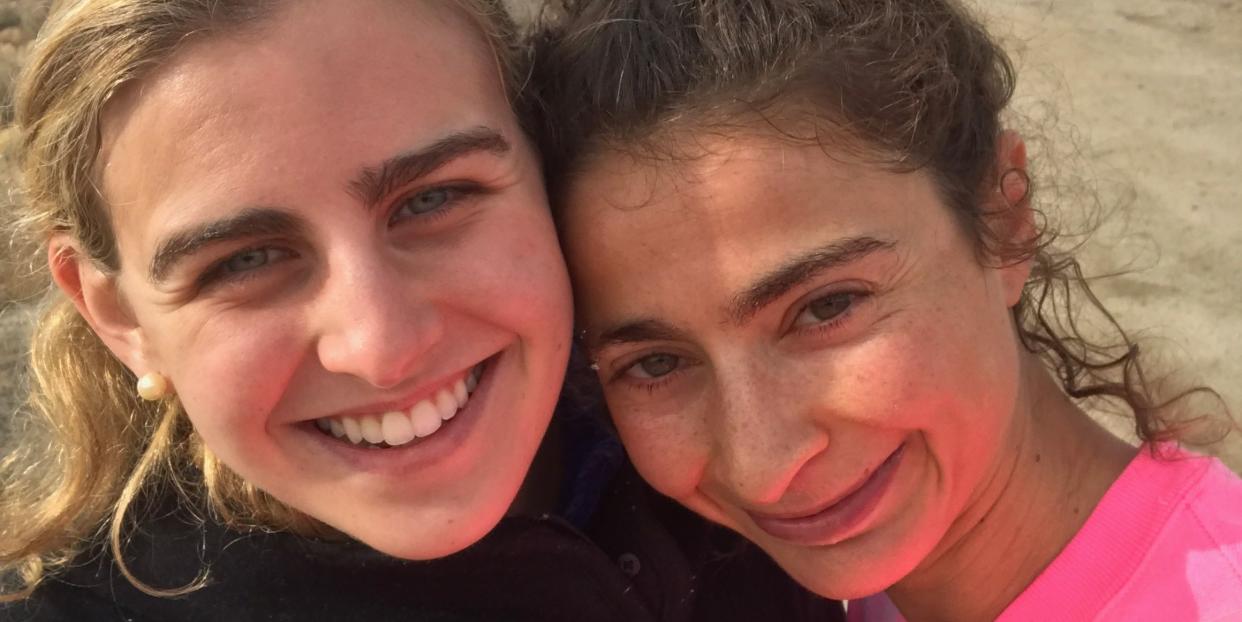
- Oops!Something went wrong.Please try again later.
- Oops!Something went wrong.Please try again later.

Mary Cain hopped to the starting line of the Wanamaker Mile at the 2013 Millrose Games in New York City. Wearing a simple black kit, she was flanked by the likes of Emma Coburn, Jordan Hasay, and Emily Infeld. To many in the packed stands surrounding the 200-meter track that night, she was an unknown, just a local kid among some of the fastest milers in the world.
Taking her place in lane six, Cain traced a cross from her forehead to her chest and from one shoulder to the other, pitched forward, and froze. One foot at the line, the other half a stride back, her elbows bent, her brow furrowed.
At the gun, Cain launched forward with a long, determined stride. She tucked in behind the pacer, Sara Vaughn, who took her through the first 200 in 34 seconds. She knew maintaining the pace would be hard, but she’d earned the right to be there. She’d qualified for the pro heat with a 4:32. She was 16.
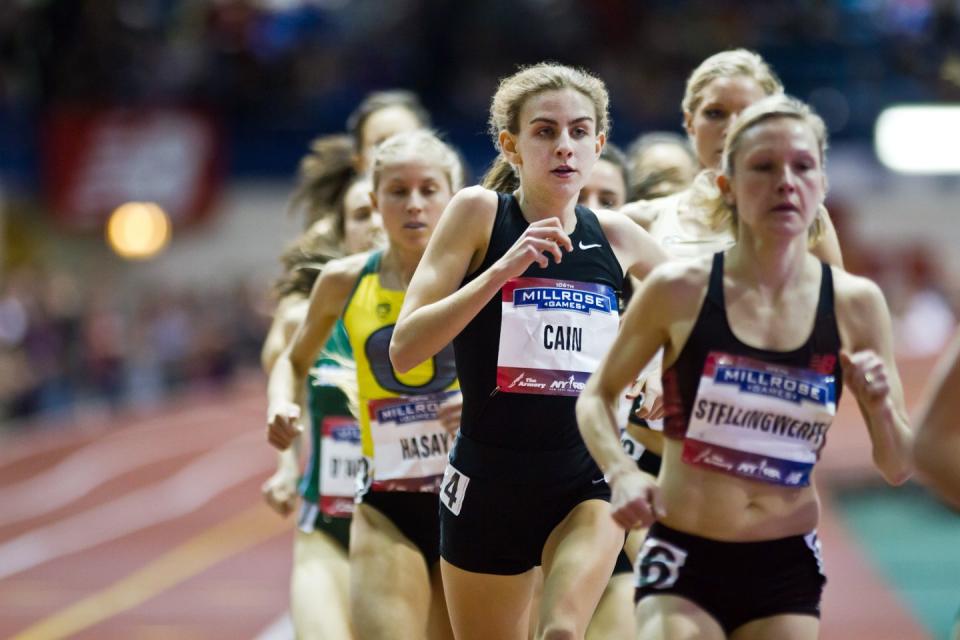
By the third lap, Cain had fallen to third place; by the fifth she’d been swallowed up by the pack. As she jostled with the other runners at a blistering sub-4:30 clip, Cain remembered the advice of her coach: “You’re in as good a shape as everybody else, and as long as you’re in it with 400 meters to go, you can’t give up.”
Shoulders hiked to her jawline, she worked her arms like two scythes slicing through the thick, dry air of the Armory on Fort Washington Avenue in upper Manhattan. She knew the track well; she had grown up just north of the city, in Bronxville, and many of the big local meets were held there. At the bell, Cain made her move. Inching forward, one runner at a time, she drifted into the outside lane, rounded the final turn, and broke into the kick that would make her famous. She crossed the line in 4:28:25, good for second overall and a new American high school record. At the same meet in 2012, she’d placed fourth among girls her own age. “I’m movin’ up!” she beamed to reporters after the 2013 pro race.
By the time she won the same race the following year, Cain had become known as the fastest girl in America and been recruited by Alberto Salazar for the Nike Oregon Project, an elite international team that had also counted Mo Farrah, Kara Goucher, and Galen Rupp among its ranks. According to Cain, Salazar told her she was the most talented athlete he’d ever seen.
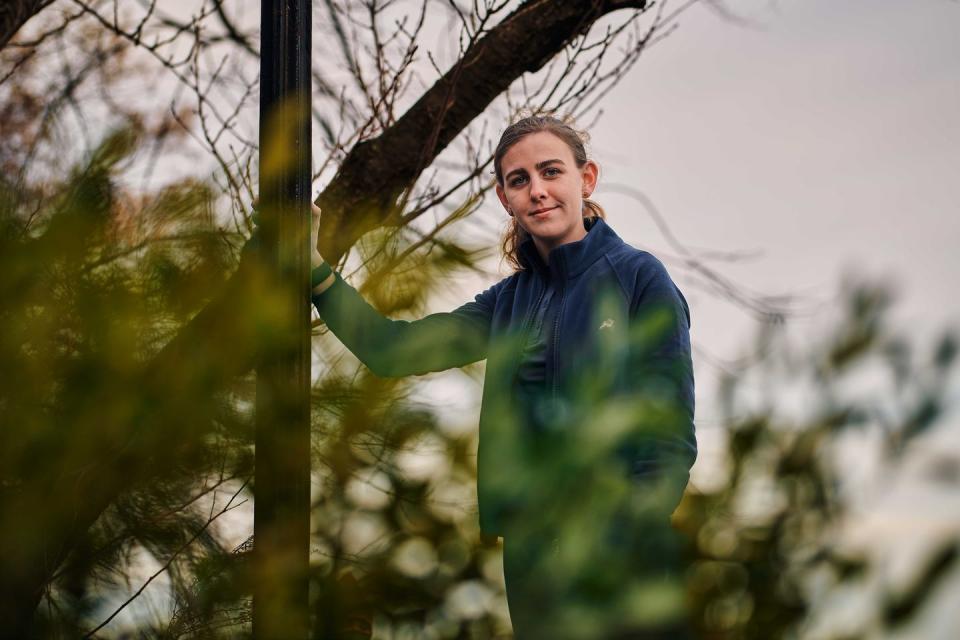
After she graduated high school in 2014, Cain moved to Portland, and for the next two years she competed for Nike at numerous pro meets. She always raced to win, even if she came to win less and less. She knew how to throw an elbow, to use the turns to gain a meter or two on her rivals, to drive her knees with unrelenting mechanical force. Her head would dip ever so slightly but her gaze never strayed, as if fixed on some invisible target on the horizon. In postrace interviews, she was cheerful and bubbly. On the track, she was a shark.
And then, in 2016, almost as suddenly as she appeared on the pro running scene, Mary Cain was gone.

Alexi Pappas remembers the night her mother slipped into the trees near their house and never came back. She doesn’t remember much else about her. She remembers the time she gave her a drag off her cigarette, when Alexi was 3 or 4. She remembers being too afraid to go downstairs one day when her parents were fighting, despite desperately wanting a bowl of cereal. And she remembers the time she caught her mom attempting to saw off her own arm in the bathroom.
Roberta Pappas died by suicide in 1995, at age 43. Alexi was not yet 5. And though her father, John, did everything he could to provide a normal childhood for Alexi and her older brother, Louis, her mother’s suicide left a permanent “mom-shaped hole” in her life. Sometimes it made her angry. “I felt abandoned by the one person you don’t want to be abandoned by,” she says.
Growing up in the Bay Area of the 1990s, Alexi filled that void with mentors and women she wanted to emulate—sports figures, like the soccer player Mia Hamm, friends’ moms, and a revolving door of European au pairs on one-year work visas. Her favorite was a tall, athletic woman from the Czech Republic named Petra, whom Pappas describes as her first real role model. One day, 10-year-old Alexi told Petra that when she grew up, she wanted to be her. Petra looked at her with kind, steady eyes and replied: “Don’t be me. Be a very big Alexi instead.”

Alexi loved sports, especially soccer. Having teammates brought her joy, a sense of belonging. She ran track, too. But while she had innate speed—she finished fourth in a cross-country state championship 5K her sophomore year—the sport brought her isolation and heartache. Once after she beat a slightly older girl at her school in a race, the girl responded at practice by getting the other kids to run the opposite direction on the track as Alexi, forcing her to run alone. “It made me sad,” she says. “It made me feel like if I do well… I might get rejected.”
Alexi excelled academically and was accepted to Dartmouth. She wanted to be a writer. She especially loved a small group of experimental poets from the 1950s and ’60s known as the New York School, which included Frank O’Hara, James Schuyler, and Barbara Guest. “Poetry taught me to have an appreciation for the word, the economy of the word,” she says.
Get the Best Stories from Runner’s World Delivered to Your Inbox 📬
Although Alexi had been recruited by Dartmouth to run track and cross-country, she says she was the worst runner on the team freshman year. But she knew she could improve; she just had to put in the work. Same as writing. She also came to realize that running, at its very best, “really is a team sport, it’s a social sport.” And it was something she could matter in. Mattering felt good.
At Dartmouth Alexi was a natural leader. Abbey D’Agostino, who would go on to race the 5,000 meters at the 2016 Olympics in Rio, recalls meeting Alexi at a frat party when D’Agostino visited the campus during her senior year of high school. Alexi was in the basement, wearing big glasses, her long curly hair cascading down her oversized T-shirt, and “amid all the chaos” she wanted to know everything about the young recruits. “She was just so curious about who we were as human beings,” D’Agostino says.
Alexi’s childhood hunger for mentors had never left; it had simply evolved. “We’re all like patchwork quilts of energy and traits from other people,” she says. “You see how it helps you and you just want more of that. You see how it helps everyone.”

But help means different things for different people. For Alexi, at least in part, it has always meant filling the void left by her mother’s suicide. “You’re on your own, figure this out,” she says of reckoning with that trauma. “Finding [friends like Abbey] was a way of figuring it out.” And not just any friends, but friends she could count on, who wouldn’t abandon her. “I wanted to find people who would bolster me, who are supportive, who I will keep for life,” she says.
Alexi says she’s sure her friends have their reasons for keeping her in their lives, but she can only speak for herself on why she keeps them: “I don’t want to be alone.”
Alexi and Abbey formed a tight bond. While other students went to parties, they had Friday night study sessions in their PJs, embracing that choice rather than dwelling on whatever they might be missing out on. At workouts, they developed a system of pulling each other through the rough patches by pretending that whoever was breathing a little easier was breathing for them both. “It was like pain was an invited guest at our birthday party,” Alexi says. “And not as some ghostly thing, but as something we jointly embraced together.”
By the end of Alexi’s senior year, she would be a two-time All-American and a qualifier for the 2012 Olympic Trials in the steeplechase. She was also accepted to several top-tier MFA programs. Alexi chose instead to do a fifth year at the University of Oregon, where the legendary track and cross-country team, the Oregon Ducks, has produced many of the best distance runners of the past 50 years. She had never planned on being a professional runner, but she had her whole life to write. She wanted to see where running might lead.
Alexi Pappas and Mary Cain were bound to meet eventually; the pro running scene is small. Still, it’s hardly intimate. A shared ability to run fast isn’t something to build a friendship on. That takes trust. And at the elite level, where even teammates are also competitors, trust can be hard to come by—especially for a shy teenage girl like Mary. But Alexi isn’t most pro runners. For her, trust is the whole point. Sometimes a person’s life depends on it.
Mary Cain arrived in Oregon for the IAAF World Junior Championships in Eugene. It was July 2014, and she was still living with her parents, preparing to move to Portland in August. Her coaches from the Nike Oregon Project were supposed to go with her but they bailed at the last minute. Mary took a Greyhound bus down from Portland by herself. It was the first time she’d ever gone to a meet alone. She’d just turned 18.
As Mary wandered around Hayward Field, she said hello to the few people she knew, watched some races, and tried to settle in. She changed into her spikes and did some shakeout drills and strides. Alexi was warming up on the track too, though they weren’t competing in the same event. She’d finished her year at Oregon and joined the Nike Oregon Track Club Elite, the company’s local pro team, and was focusing on longer distances. A mutual acquaintance introduced them. Alexi felt an immediate connection. She was drawn to Mary’s greatness as an athlete, but more than that, she sensed her intelligence.

The atmosphere at Hayward Field was chaotic and loud. Spectators, media, and other athletes filled the stadium; all eyes were on the 18-year-old phenom in the red Nike Oregon Project kit. Everyone wanted to see how this breakout star would fare against an international field of elite women in the 3,000 meters, almost twice the distance in which Mary had made her name the year prior.
At the gun Mary went out hard like she always did, and locked in with the lead pack. She ran steady splits of around 3:04 for her first two kilometers and then dropped the hammer, blazing through the final K in 2:51. She won the race in 8:58, outkicking two Kenyans by more than two seconds. The stadium erupted. After Mary gave her postrace interviews, where she spoke of the brutal intensity of international racing, Alexi invited her to lunch—someplace more conducive to conversation. They grabbed some vegetarian food at a local market and ate at a picnic table outside.
Alexi didn’t waste time with running talk. She began asking Mary about her love life, what she wanted to major in. “Simple questions that every 18-year-old expects, that I found myself not getting,” Mary says. Most people were interested in only one part of her, she says, “and that was the part that brought success.” Speaking frankly with a stranger was new. Alexi was talking to her like an adult.
Mary felt like a kid in comparison. Alexi, who was 24, had had an entire NCAA career. She was moving into a house and starting to work on her first feature film, Tracktown, with her longtime boyfriend, Jeremy Teicher, whom she’d met at Dartmouth. She seemed so grown up. Mary wanted Alexi to like her. She self-edited constantly. Alexi asked Mary if she was having fun in her workouts, if she was doing interesting activities with her teammates. “I remember thinking, Wow, I wonder why no one else is asking me these things, but also, I’m kind of lying when I say everything is fine.”
What Alexi did not see, what even Mary hadn’t yet come to recognize, was the young runner’s suffering. “I was at a tipping point, where a lot of my issues were starting to culminate, at World Juniors,” Mary says now. “That’s where my weight became a topic of conversation, where I’d seen the warning signs, but it hadn’t spilled over yet. And looking back, I just remember Alexi asking me these super simple questions that should have elicited simple answers, but I felt uncomfortable answering.”
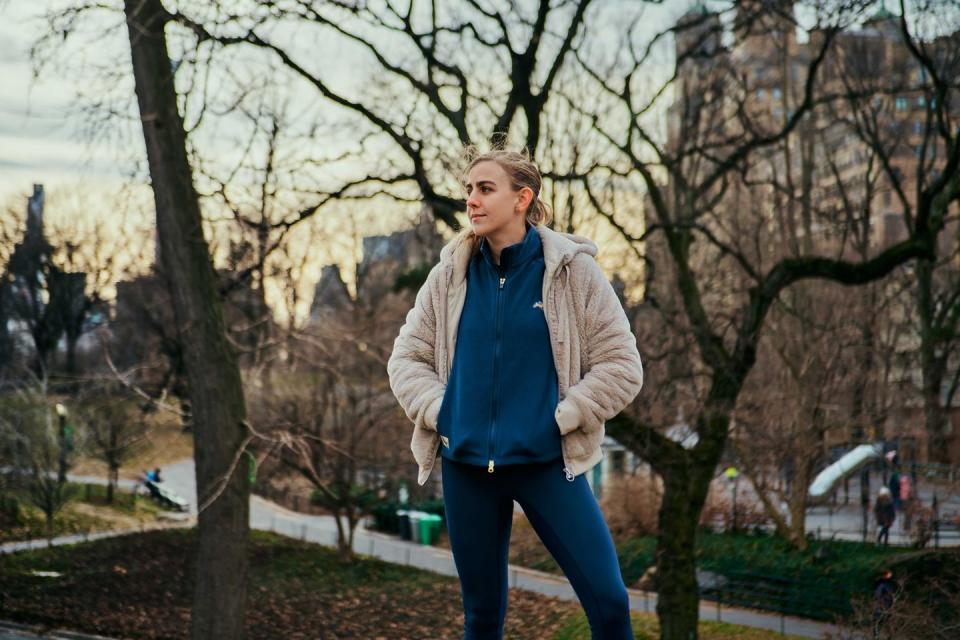
In 2014, that awareness was still years away. Mary didn’t know what her life in Oregon would bring, but she knew she was on her way. She exuded optimism. “When I met Mary, she was at the top of her game, so she didn’t seem to need a friend in the way we became friends,” Alexi says.
What Alexi had interpreted as self-assurance was, in fact, a dense scaffolding of defenses that Mary had already begun to erect. Mary says that if she’d met Alexi any later, it would have been too late. “After [World Juniors] everything became just so rigid and structured, and I didn’t have the ability to let somebody in,” she says.
In the two years they were both in Oregon, over shakeout runs and lunches at various track meets, Mary and Alexi grew close. A scheduled one-hour meetup would turn easily into three or four hours. They always had a lot to talk about: the books they were reading, Mary’s classes at the University of Portland, what they were training for. Despite their rapport, there were things that Mary never shared, with Alexi or anyone else. “I was struggling with a really powerful and deep depression,” she says now. She worried that if she said what she was really feeling, she might “get tattletaled back to the coaches.”
And after Mary left the Nike Oregon Project and went home to Bronxville, in October 2016, she and Alexi didn’t keep in touch beyond the occasional text. “I was in such a bad place,” Mary says now. She didn’t want to be a burden. But looking back, she sees that Alexi had “opened the door and left it ajar, ready for me to walk back through it,” if and when she was ready.
Alexi Pappas walked onto the track at the Olympic Stadium in Rio de Janeiro. She took one last swig from her water bottle and pitched it to the turf. She joked with the runner beside her, Sitora Hamidova of Uzbekistan. Pappas wore her hair in a bun, as she always does when she runs, and smiled nervously for the camera as it panned across the row of women about to race the 10,000 meter final at the 2016 Olympic Games. Pappas, who has dual citizenship, would be competing for Greece.
She hadn’t come to win, or even to place. She just wanted to break her own Greek national record, which she’d set a few months prior at the Payton Jordan Invitational at Stanford University. Besides, her competitors in Rio included Tirunesh Dibaba, who’d won gold in the same event at the 2012 Olympics in London, and Almaz Ayana, who would not only win gold that day but also set a new world record, in 29:17. Pappas finished 17th, in 31:36, shattering her old record by 10 seconds. She stood on the track until the last runner finished the race, cheering them on, taking it all in. The screaming crowd, the breathless commentators, this newfound community of Olympians. Bliss.
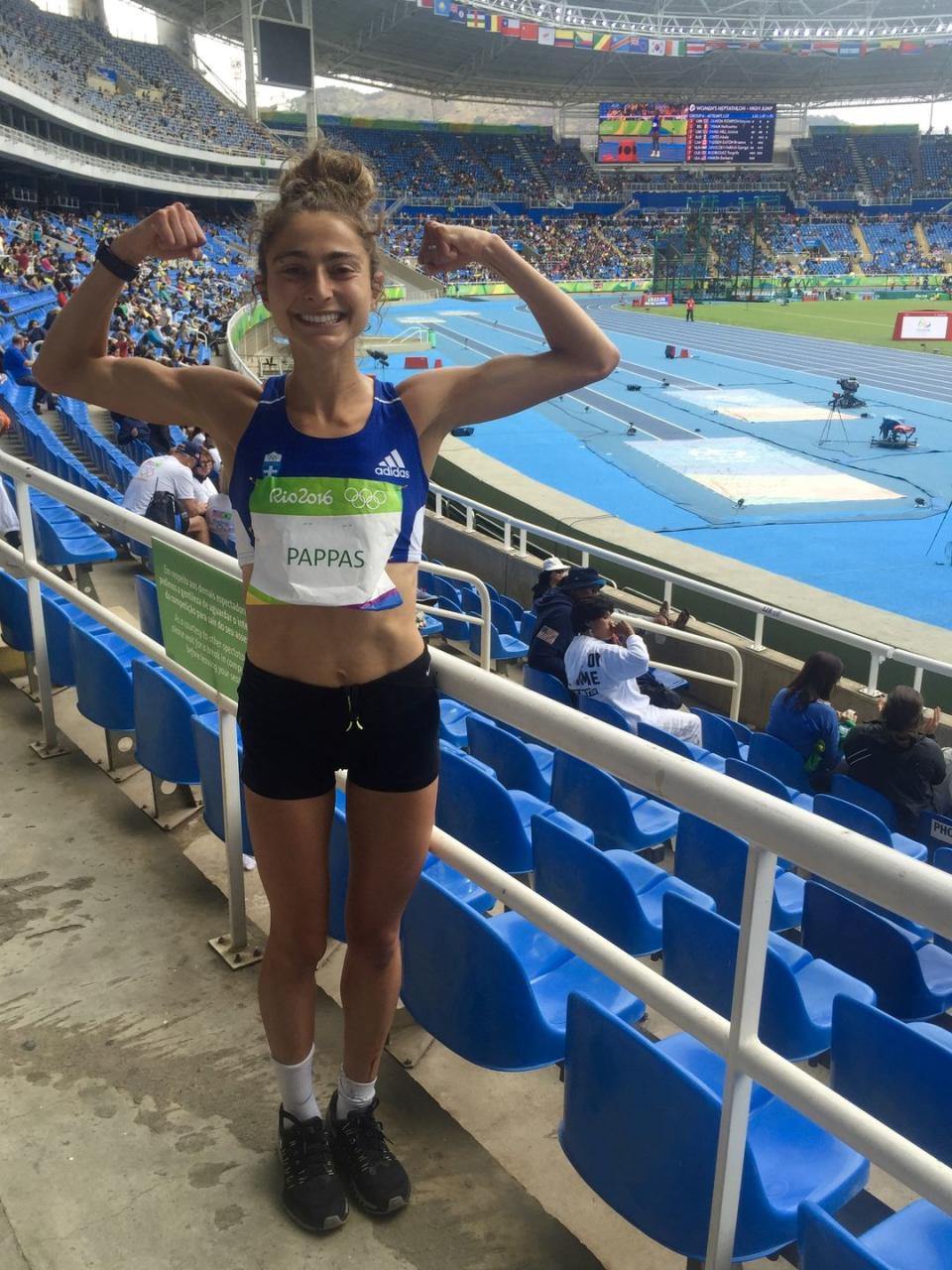
Then it all fell apart. Post-Olympic emotional dips are common; once athletes reach that ultimate milestone, they often feel like they’ve fallen off a ledge. Alexi says that for her, it was more like falling off a cliff. She returned to her training camp in Mammoth Lakes, California, and dived right back into her pre-Olympics regimen. She wasn’t sleeping much, but was still running 120 miles a week, most at altitude. She ran hard tempos, doubles, and long runs of 20 miles plus, even as she depleted every resource she needed to function. If her body were a car, you could say she was running on empty, and then without oil, and eventually without gaskets. By the winter of 2017, she’d torn a hamstring and couldn’t run at all.
Alexi’s father and brother were concerned; they knew the warning signs. She was beginning to act like her mother. She’d simply replaced overt forms of self-harm with something more socially acceptable. She and Jeremy had gotten engaged and already sent out invitations to their wedding, but they decided to postpone until further notice.

Alexi told almost no one what she was going through, not even D’Agostino or Jordan Hasay, who became one of Alexi’s best friends at the University of Oregon. Both women describe Alexi as genuine and open. “I could tell her anything and she didn’t judge me for it,” says Hasay. For Alexi to be this closed off, even to her closest friends, indicated that this was no minor case of post-Olympic malaise. She was sick.
But one friend, another Oregon teammate named Anne Kesselring, Alexi didn’t have to tell. By this point Alexi had gone back to Eugene, and Kesselring had come from her hometown in Germany for a brief five-day visit. She immediately saw it in Alexi’s face, heard it in her voice. On a walk through the woods Alexi finally broke down. Anne called another of their former teammates who was still in Eugene, and the three of them spent the weekend together. They wouldn’t let Alexi be alone. Not like this.
At her father’s urging, Alexi started to see a psychologist, who helped her recognize that she’d suffered an injury to her brain and had to attend to it. As an athlete, Alexi understood the metaphor implicitly. Her depression did not define her any more than her torn hamstring did. And she needed to heal.
Mary sits tall, looks straight at the camera, and speaks steadily, with poise. Millions of viewers watch her deliver a scathing assessment of her time with the Nike Oregon Project in a video op-ed published on November 7th, 2019, by the New York Times. She says the all-male staff designed her training plan with no consideration of her still-developing body. She says she was weighed publicly and shamed for not hitting the weight that Salazar had arbitrarily decided was ideal for her. And she says that the one time she tried to tell Salazar she was struggling emotionally, he replied that he was tired and was going to bed. (Salazar has denied the allegations.)
In the B-roll of her on the track interacting with kids, she smiles easily, warmly. Just the year before, Mary had been in a very different place. She hadn’t just quit the program; she’d gone home to regroup. During her time out of public view, she had tried to forge an identity beyond running, rebuilding herself both emotionally and physically. Sometimes she’d run along the path of East River Park, a stretch of public recreational facilities in lower Manhattan. She seldom ventured onto the track there. She hadn’t raced in two years. She hadn’t laced up a pair of spikes, or pinned a bib to her singlet, or felt the rush of circling a track at 14 miles per hour. She missed it. She missed training; she missed competing; she missed being the best. But mostly, she missed feeling like an athlete.
Once the fastest girl in America, Mary says she watched her career sputter and her health deteriorate. She says she developed an eating disorder. She says she stopped menstruating and her bone density plummeted. Injuries became routine. She says she broke five different bones. She says she began cutting herself and having suicidal thoughts. She says she’s ready to close that chapter of her life and move on.
She and Alexi had reconnected at Alexi’s wedding to Jeremy, which they’d finally celebrated in June of 2018. Mary describes the months that followed as a “waterfall” in the growth of their friendship. The occasional text became regular phone calls, and by winter, Alexi had invited her to join her for a month of training in Mammoth Lakes. At nearly 8,000 feet above sea level, the small town in east-central California, just south of Lake Tahoe, has long been a mecca for professional runners.
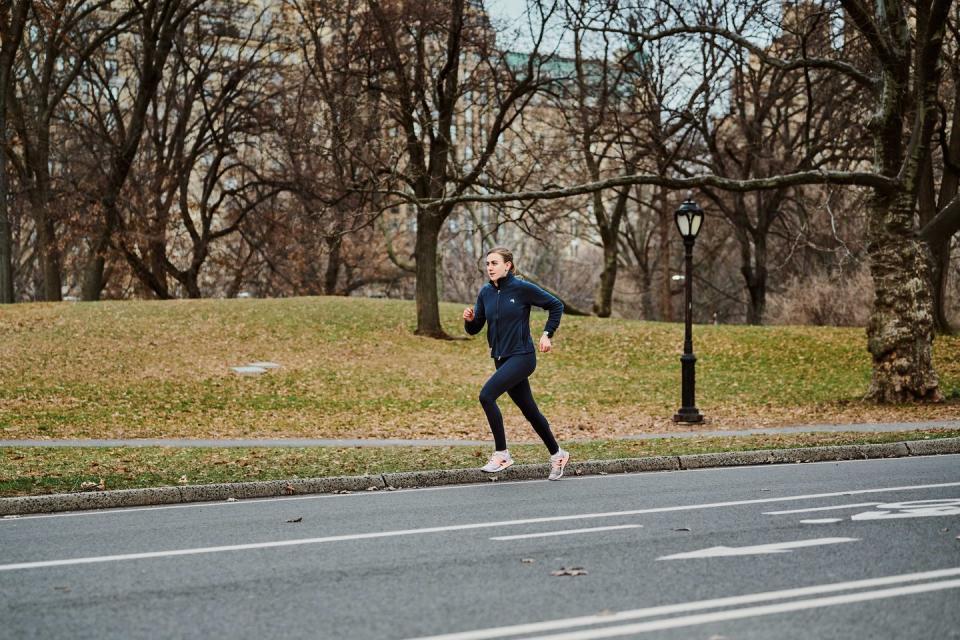
Alexi was just finding her legs in the marathon. She’d run her debut in the distance three months prior, at the 2018 Chicago Marathon, and after a short break returned to Mammoth to resume training full-time. She’d set her sights on the 2020 Tokyo Olympics. It was more than a year away, but she had work to do. She knew she could run a lot faster than her Chicago time of 2:43. Alexi’s training partners that winter included Deena Kastor, the bronze medalist in the 2004 Olympic marathon, and Sarah Attar, the first woman to compete in an Olympic Games for Saudi Arabia. Mary would fit right in.
But when Mary arrived, she couldn’t run a step without dragging her left leg. A pinched nerve in her back had led to an imbalance in her form. She’d be courting disaster if she kept trying.
Mary got a room in town and tried to fill the time. On one of her first nights there, Alexi invited her over for dinner. Alexi’s Mammoth Lakes condo is a split-level with a large, open living area where a treadmill occupies a central space between the kitchen and the couch. They greeted each other with a big hug, opened a bottle of wine, and sat down to catch up.
Alexi could see Mary’s frustration. This trip was supposed to be the start of her comeback and she could barely walk. Alexi had a few ideas. They got up from the couch and walked over to Alexi’s Exxentric, a flywheel-powered strength training machine that looks more like a medieval torture device than a piece of exercise equipment. Mary had never seen one before. As Alexi demonstrated how Mary might use the device to relieve her pain, Mary stood a few feet away, folded her arms across her chest, and watched.
Although the two women had known one another for five years, she was wary. “I was just so shocked that somebody would be this altruistic,” Mary says. “Coming from a program where someone would stab you in the back before they’d hug you... Like, is this thing actually going to help me, or am I going to break my back?”

But something in Alexi’s eyes suggested that she, too, knew about pain. Soon they were sharing their very lengthy sagas of physical setbacks. Mary began to cry. “I’m not even upset,” she remembers saying to Alexi that night. “It just feels so nice to tell somebody.” Up until then, she’d learned to not tell anyone anything. “It was really the first time that I had given somebody the whole picture of the injuries I’d had,” Mary says.
The month passed quickly, and Mary returned to New York. In May 2019, she ran her first race in two and a half years, a four-miler in Central Park with over 4,000 runners. She won it by more than 90 seconds. The media exalted her win: Mary Cain was back.
Still, no one really knew where she’d gone. Not even Mary. Despite everything she’d dealt with, Mary hadn’t begun to fully reckon with her time at Nike. Indeed, she often found herself defending the program, even as Salazar was investigated for allegedly doping some of his athletes. She thought she had been the problem. She held out hope of going back, once she was healthy enough to run professionally again.
But in October 2019, when news broke that Salazar had been banned for four years by the US Anti-Doping Agency and the Nike Oregon Project was shutting down, Mary began to reflect on her time there. She read the USADA report detailing far-ranging complaints against Salazar, and for the first time she saw on paper “some of the same lies” he’d told her. Until that moment, she had not recognized them as lies. But as she assembled the pieces, a picture began to emerge. Her depression, her health issues, her injuries. It all fell into place. She called Alexi. Their talk about injuries earlier that year had led to deeper conversations about their experiences with depression. Mary knew she could count on Alexi to listen.
Alexi put Mary in touch with an editor at the New York Times. “Your reckoning deserves more than a tweet or an Instagram post,” she said to Mary on the phone that day. “You deserve more than that. The story deserves more than that.”
“Alexi was along for part of that roller-coaster ride,” Mary says now, “where I started going on this journey and suddenly realizing, Oh my God, this whole thing is so wrong and so cruel and so meant to gaslight me and take away some of that ability to recognize abuse for what it is.”
WATCH: Mary Cain’s NY Times Video Op-Ed
These days, Mary is living in Manhattan with her boyfriend, Jake, and training again. Last summer she had surgery to repair torn labrums in both hips and is fully recovered. She’s being coached by a former Olympian from New Zealand named John Henwood and focusing again on the mile. She finished college at Fordham University, where she majored in business administration, and is working as a community manager for Tracksmith and coaching for New York Road Runners. She turned 24 last May.
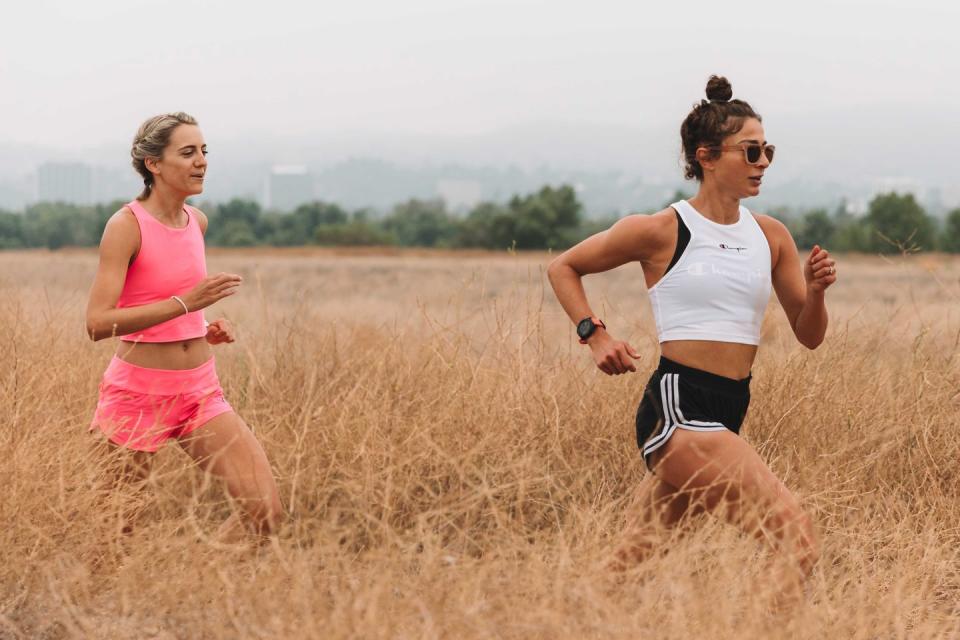
Alexi also continues to train at an elite level, and spent most of this past fall camped out in Boulder. In December, she published a New York Times video op-ed of her own, sharing publicly for the first time her struggles with depression following the 2016 Olympics.
She’s also been busy publicizing her first book, Bravey: Chasing Dreams, Befriending Pain, and Other Big Ideas, in which she writes with a poet’s economy of word and a filmmaker’s grasp of narrative about her mother’s suicide, her depression, and the patchwork quilt of relationships that’s helped to define the woman she is today. She says she wrote the book to not only work through her own pain, but also to provide a kind of “satellite mentorship” to anyone who might read it, especially the girls and young women who make up the bulk of her fanbase. She wants them to know they’re not alone. “I can’t meet every single person who comes into contact with this book, but I hope it feels like we’re together,” she says. “That was so important to me growing up, and it’s still important to me.”
Abbey D’Agostino joined Alexi in Boulder for a few weeks this fall. Both are training for the 2020 Tokyo Olympics (rescheduled to 2021), where Pappas hopes to race the marathon for Greece, and D’Agostino the 5,000, an event in which she has “unfinished business,” she says. At the 2016 Games, D’Agostino tripped with 1,600 meters to go, and limped her way through the final four laps on a torn ACL. Alexi was in the stands watching, and immediately after the race she rushed to the medical tent where D’Agostino was being treated. “It was the most Alexi thing,” D’Agostino says, “for her to just smuggle her way in to get to her friend.” And just as quickly as Alexi appeared, and made D’Agostino laugh, she was gone. “She knows me, and she knows I’m easily overwhelmed,” D’Agostino says. “So she checked in but she also gave me room to breathe.”
Alexi and Jeremy recently bought a house in Los Angeles, where they moved to be closer to the film industry. Last winter, the couple flew to New York to premiere their second feature film, Olympic Dreams, a bittersweet drama starring Pappas and the actor Nick Kroll, and shot entirely by Teicher inside the Olympic Village at the 2018 Games in PyeongChang.
The morning of the premiere Alexi and Mary led a group run in Central Park, organized by New York Road Runners. After four miles at an easy, 8-minute pace on the park’s bridle path, they posed for photos and talked with the few dozen people who came out. Then they set off to do another loop, just the two of them. They had a lot to catch up on.
The National Suicide Prevention Lifeline provides 24/7, free and confidential support for people in distress, as well as prevention and crisis resources for you or your loved ones. Call 1-800-273-8255.
You Might Also Like

